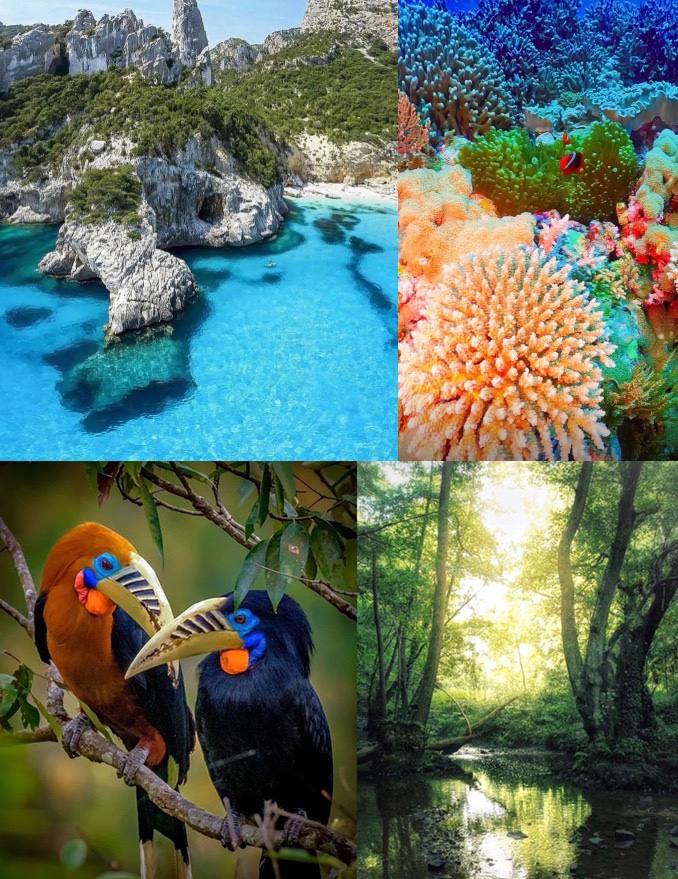
“The starry sky of nature’s great paranoma that shines like a jewel on a sandy beach”
“Rivers, seas and lakes that flow leisurely in the clear color of amber blue”
“Mountains where animals and plants live in a brave and powerful environment in a rich natural ecosystem”
…These are natural environments that can be said to be “natural” that we have seen at least once.
As of 2021, due to the rapid increase in abnormal weather including natural disasters such as global heat waves, droughts, and floods, those water resources, atmospheric environment, animals and plants have already exceeded the thresholds that can withstand, serious environmental pollution has accelerated, and trees and corals Species such as animal and plant organisms are disappearing and becoming extinct in large quantities every moment.
These problems are occurring at the same time throughout the world, not in each country, and the impact is expanding in a chain all over the world.
Not only developed countries, but especially in developing countries where social infrastructure has not been developed, millions of people are directly damaged by serious food insecurity, food shortage, water pollution, water shortage, loss of housing, etc. every year due to these abnormal weather conditions. It is the actual situation of the world that there are 1 in six people (multidimensional poverty) in the world’s population who are in a situation where it is difficult to live healthily due to secondary disasters. ( United Nations Development Program (UNDP) from 2019)
In order to prevent the expansion of losses such as natural environment conservation, biodiversity, and social life of mankind as a whole, it is necessary to rapidly and significantly reduce greenhouse gas emissions and at the same time accelerate rapid and concrete actions to adapt to climate change. . ( There are other causes of climate change.)
In the “1.5 Degrees Special Report” of the IPCC (*1), which was temporarily issued in 2018, it is clear that at the current accelerated pace of global warming, resilient (natural resilience) (*2) development in response to climate change is already difficult.
If global warming exceeds “1.5°C” after the Industrial Revolution, the improvement situation will be further constrained. In some areas, if global warming exceeds “2°C”, it will be impossible to develop resilient to climate change.
For example, it is predicted that the coral reef will disappear by 70-90% with the rise of “1.5 degrees” and 99% with the rise of “2 degrees”.
If it can be kept to “1.5℃”, there is a considerable possibility that most of the ice sheets in Greenland and the western Antarctica will be able to stop the collapse, but with the rise of “2℃”, almost all ice sheets will collapse, and sea level rise is the highest in the world 10 It is said that there is a possibility of reaching meters.
Currently, it has risen “1.09℃” since the Industrial Revolution. The results of this survey severely emphasize the urgency of climate action.
It has been shown that reducing the temperature rise to “less than 1.5 ℃” instead of “2℃” is important in solving social issues such as poverty in the world, in addition to preserving the natural environment and biodiversity.
As the world population continues to grow, the pace of temperature rise “1.5℃” can be said to be the limit value that humanity must protect in order to maintain the current standard of living.
In order not to destroy and maintain the legacy of the natural rich global environment of irreplaceable biodiversity for children and all people of the world, and to connect the baton to future generations, especially for us living in developed countries. We believe that it is essential to realize the expansion of awareness to “a sustainable society” (*3) and “sustainable society” (*4) from a familiar environment.
“Recycle Town” to tackle climate change
Japanese subtitles version)
※Excerpt from United Nations Information Centre | United Nations Information Centre
*1 IPCC: (Intergovernmental Panel on Climate Change) The Intergovernmental Panel on Climate Change is 19 by the World Meteorological Organization (WMO) and the United Nations Environment Programme (UNEP) It is an intergovernmental organization established in 1988, and as of August 2021, 195 countries and regions are participating.
※2 In the environmental field, Resilient is the ability of the ecosystem to respond to perturbation or disturbance by resisting damage and recovering quickly. Such chaos and disturbances include human activities such as fires, floods, storms, insect population explosions, deforestation, rough ground for oil extraction, pesticides sprayed on the soil, and the introduction of exotic plants and animal species.
※3 “Sustainable society” means “sustainable society”. It is a society that does not destroy the earth’s environment, does not use too much resources, and future generations can continue to live peacefully and richly on a beautiful earth.
※4 Sustainable development is defined as “development that satisfies the needs of future generations while satisfying the needs of current generations.”
Our organization actively engages in the following activities and actions.
0 activities of garbage coming out of the home
Utilization of farmland and vacant land
Learn more about compost
Environmental beautification activities
Sustainable development support activities in developing countries including the above contents
